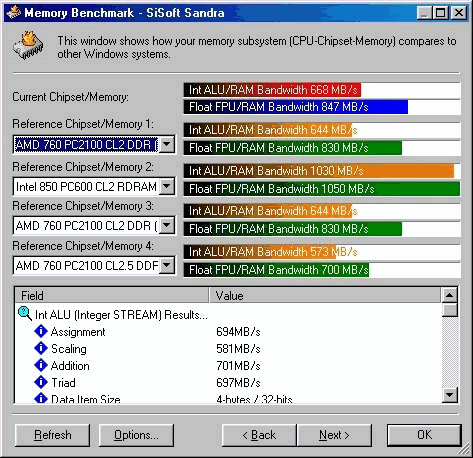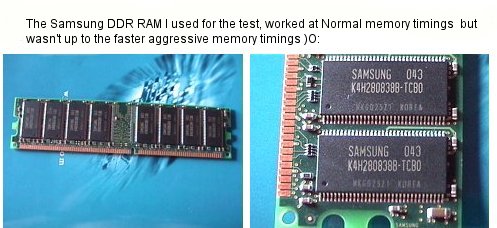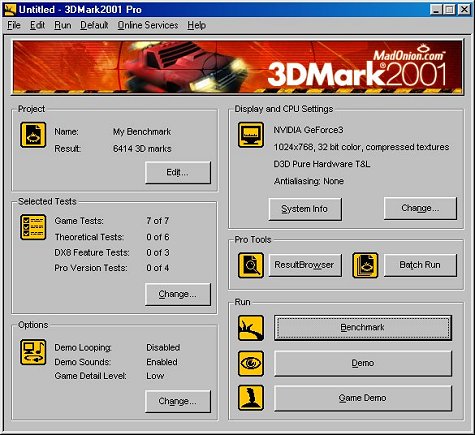Overclocked Results
Memory BenchmarksI tried tweaking the memory timings in the BIOS but there wasn't much room for maneuver at 150MHz FSB, The Samsung CAS 2.5 RAM is obviously at it's limits, I did get a few benchmark at 150FSB, as shown below

BIOS Screen shots
Here are a few overclocking related BIOS screenshots showing the FSB adjustment within the BIOS and the PC health status which monitors the CPU Core Voltage, as you can see the CPU core voltage is at 2.01 volts this is what I ran the CPU at to try and get it stable at over 1517MHz but it just didn't want to run games over 1517MHz.



Game Benchmarks
To run the Overclocked game benchmarks the RAM timings in the BIOS are set to Auto, this means the RAM timings are taken from the EPROM on the RAM stick, so in theory it should be within the specs of the RAM, as I mentioned above 150MHz was completely stable, 151MHz caused some crashes, I think basically the RAM is the limiting factor here, I've seen reports of FSB speeds up to 155MHz and even 160MHz on this board.
As the system is stable at 1500MHz @ 150FSB I've decided to run a few benchmarks showing just what the system is capable of. I think most people who buy this board will be overclockers or avid gamers and as such high FPS and 3DMark 2001 scores is what you want, so in the next few tables and graphs I've tried to show just what sort of results you will achieve with some of the latest hardware around.
First off lets see some Quake 3 Benchmarks.
| 150FSB * 10 multiplier | 640*480 | 800*600 | 1024*768 | 1280*1024 | 1600*1200 |
| Fastest | 187.1 | 185.4 | 179.4 | 150.1 | 111.1 |
| HQ | 173.4 | 169.3 | 150.9 | 106.8 | 75.5 |
| EHQ | 168.7 | 164.7 | 140.1 | 93.9 | 66.2 |

These results are all pretty darn quick. The Epox board along with an AXIA Thunderbird and a GeForce 3 make an awesome gaming rig. The DDR memory and the fact that the FSB is stable at 150MHz all help nudge the scores upwards.
3DMark 2001
3DMark 2001 from Madonion, is one of the most talked about benchmarks around, in the hardware community. A fierce contest is fought to get the highest 3DMark 2001 score. Obviously this motherboard is very capable as a games machine, so I've again tried my best to see what sort of scores it can achieve.
I've looked on the Madonion site and read some of the forums, the scores I get on the benchmark aren't as high, the leaders who get over 7000 points, but they are very good for a stock board and a readily available AXIA Thunderbird CPU. And lets not forget I'm using Air cooling with a fairly normal heatsink.
I ran 3DMark 2001 at the default benchmark settings
| 3DMark 2001 | 640*480 | 800*600 | 1024*768 | 1280*1024 | 1600*1200 |
| 1500MHz DDR GF3 | 6680 | 6370 | 5707 | 4602 | 3630 |
| 1500MHz DDR GF3oc | 7260 | 6978 | 6383 | 5332 | 4197 |

In an attempt to get the highest 3DMark score I could I installed the older Detonator 10.80 drivers which are supposedly faster in 3DMark2001 than the detonator 12.00's. I managed to break the 6400 barrier for the default benchmark. Pretty good methinks, now if only I had better CAS 2 DDR RAM. If I could enable the Fast setting in the BIOS and run the FSB up to 155 or more, and my score would definitely be better, but as it is right now, I like it. I'll just have to wait till PC2400 DDR RAM becomes readily available, or even the just announced PC2700 RAM. To break the 6400 barrier I had the GeForce3 at 235MHz Core 540MHz Memory and I had the FSB at 151MHz, My CPU was running at 1510MHz.

At this speed the Graphics card and RAM where pretty much stressed to the max, so I wasn't able to run the complete test.
Click here for the 3DMark2001 ORB results http://gamershq.madonion.com/compare2k1.shtml?1015469
To run the complete test I had to turn the GeForce3 down a bit, to 235Mhz Core 535MHz memory and I managed to run the full test Click here for the 3DMark2001 ORB results: http://gamershq.madonion.com/compare2k1.shtml?1017336









